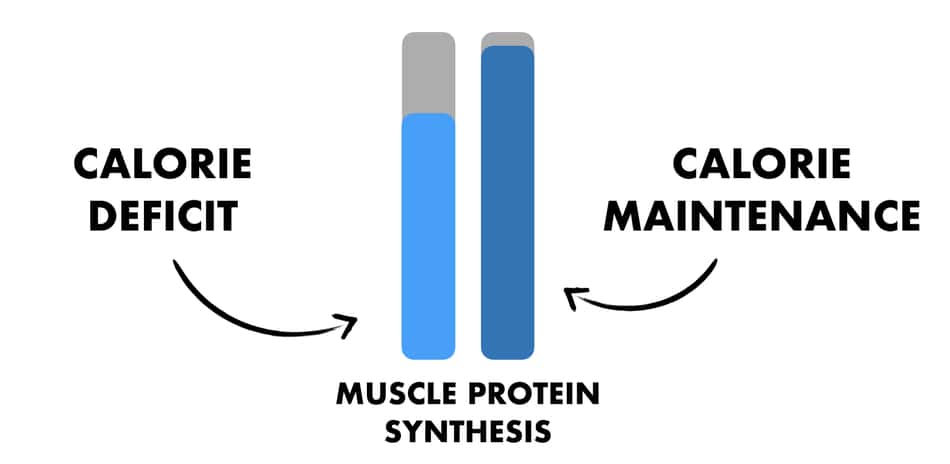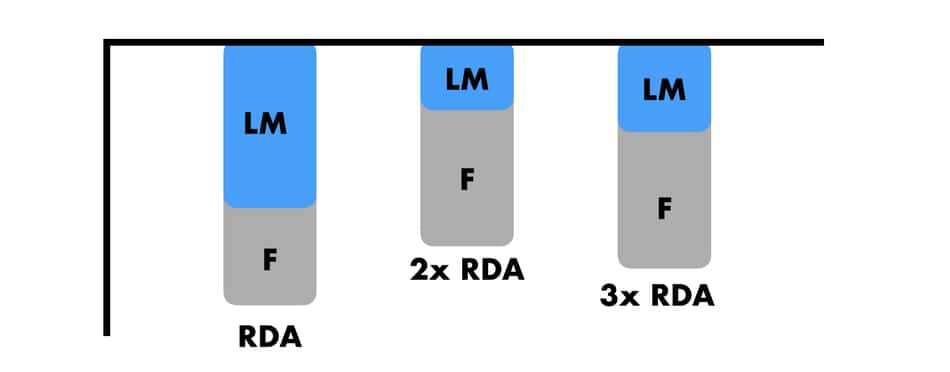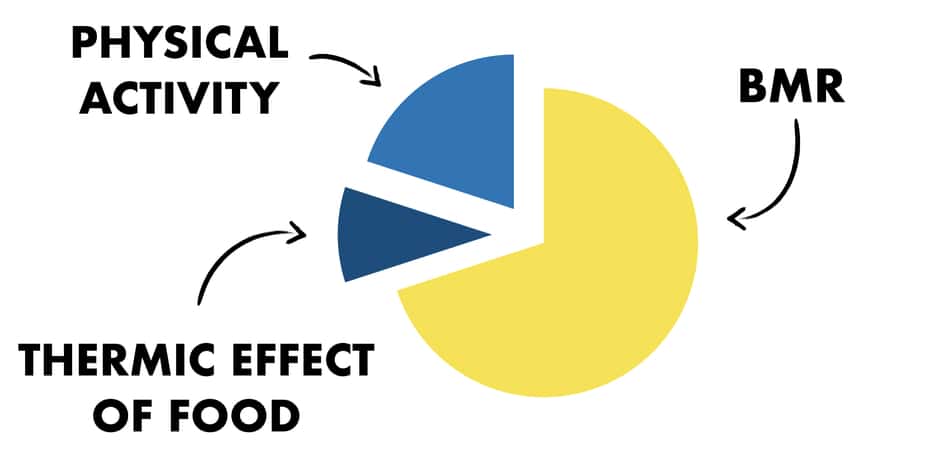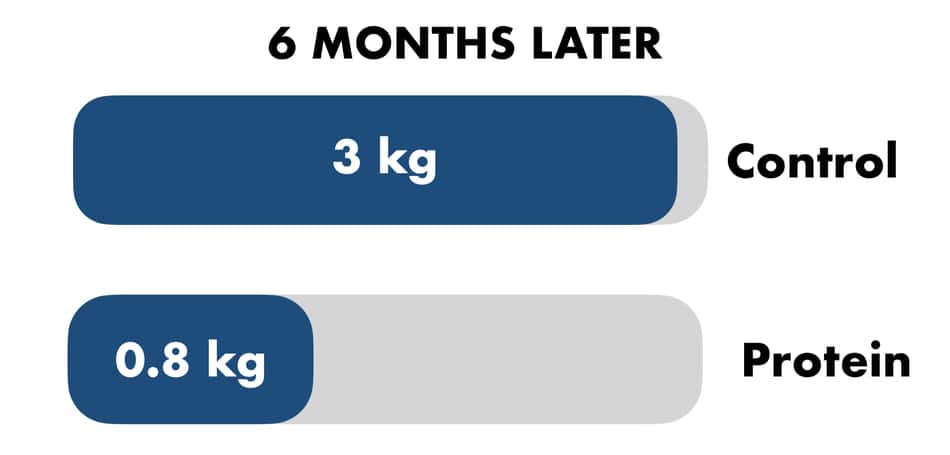Studies show that 20-30% of weight loss comes from lean body mass (muscle). That’s why an adequate protein intake while being in a calorie deficit is really fundamental not only to losing weight but also to maintaining metabolism.
In this article I will explain everything you need to know about protein intake and how much protein should you eat in a calorie deficit.

Generally, you should eat between 150 – 200 grams of protein per day in a calorie deficit, which accounts for 2-2.5 grams of protein per kg per day. The number will depend on how much food you eat, your current body weight, and your overall physical activity.
This is almost 3x higher than the “normal”, recommended daily allowance. Here’s why.
Protein needs go up during calorie deficit
One of the reasons why you should consume more proteins during calorie deficit is due to the changes in protein synthesis and protein breakdown.
In a nutshell.
- During dieting, there is a noticeable downregulation of muscle protein synthesis and an increase in muscle protein breakdown.
- This decreases lean body mass and lowers the total daily energy expenditure.
When you’re dieting, your body starts to make some metabolic changes to save as much energy as possible. It’s kind of like when you want to save up money, so you stop spending them on left and right.
Some of those complex physiological adaptations often promote weight regain. The longer we stay in the deficit, the harder it gets to lose weight.
Its kind of like the body is doing everything it can not to lose weight and restore energy balance.
Metabolic changes during calorie deficit
Here are some of the examples of those mentioned before adaptations:
- Decrease in protein synthesis (the body uses fewer proteins to build cells)
- Increase in protein breakdown (the body prefers to use already existing “amino acid pool” and catabolize lean body tissue aka muscle loss)
- Decrease in metabolic rate (we burn fewer calories)
- Changes in appetite control (we feel more hungry)
The most important for us is the fact that when we’re in a calorie deficit, our body simply refuses to convert the proteins from the food we eat and is preferring to break down the lean body tissue.
The optimal level of protein intake during the “maintenance” calorie intake, in the calorie deficit becomes suboptimal (less than usual).
Let me illustrate that to you.
Calorie requirements when dieting – case study
The study done by Stefan Pasiakos, Ph.D., on 12 healthy men and women documented how does muscle protein synthesis changes during the calorie deficit.
The study period was divided into two parts:
- Calorie deficit (10 days)
- Calorie maintenance (10 days)
All participants were eating the same amount of proteins (1.5 grams of protein per kg) during both time periods.
In the first 10 days, everyone was on a moderate calorie deficit, whereas in the last 10 days, everybody ate at the maintenance level.
The results
The results showed that during the energy deficit period, on average, the muscle protein synthesis was reduced by 19%.
See below.

This means it only took 10 days of moderate dieting to significantly lower the ability to maintain a lean body mass (source).
NOTE: Please note that during this study, the amount of protein was 1.5 grams per kg of body weight, which is considered twice more than recommended daily allowance. Yet still, it was not efficient to maintain optimal protein synthesis.
Now, let your mind drift for a moment and imagine what would happen if that project would continue for another 20, 50, or even 100 days.
We can only speculate that the amount of lean body tissue would be significantly lower.
As you will learn in a moment, with lower lean body mass our metabolic rate drops. So the likelihood of gaining weight back goes significantly up.
I know what you may be thinking now. How much protein is enough during the calorie deficit to not lose lean body mass?
How much protein should I have in a calorie deficit?
Generally, you should have around 2.0g – 2.4g of protein per kg per day while being in a calorie deficit. High protein intake during the hypocaloric diet ensures to maintain muscle protein synthesis, preserve more lean body mass and increase your daily energy expenditure.
What exactly is 2.0g – 2.4g of protein per day? This will depend on your current body weight and physical activity.
People who are physically active generally need more protein than usual.
On average, 2.0 -2.4 g per kg is equivalent to around 130 – 200 grams of protein per day.
I understand that getting 130 – 200 grams of protein from food may feel doubting. A good alternative is to use whey protein powder supplements. This way you can increase the number of proteins, without adding too many calories.
How much protein is enough?
A more recent study done by the same researcher compared 39 adults who were (this time) divided into three separate groups:
- Low protein 0.8 grams per kg (recommended daily allowance)
- Medium protein 1.6 grams per kg (2 x recommended daily allowance)
- High protein 2.4 grams per kg (3 x recommended daily allowance)
In the table below, you can see the average consumption of each macronutrient for each of the groups during the 30 days of calorie deficit.
RDA group consumed low protein, 2x RDA medium, and 3x RDA high.
| RDA | 2x RDA | 3x RDA |
|---|---|---|
| 64 g of protein | 122 g of protein | 185 g of protein |
| 272 g of carbs | 199 g of carbs | 121 g of carbs |
| 64 g of fat | 61 g of fat | 58 g of fat |
As you can see, with the higher protein intake, the fat intake remains similar, but carbs go down.
- Total calories were the same for all three groups.
- The only difference in calorie intake between all three groups was in the macronutrient ratio.
All participants were on the same 40% calorie deficit for 30 days (30% from reduced food intake and 10% from increased physical activity).
The results? All people lost on average 3.2kg of body weight during the 30 days (source).
| RDA | 2x RDA | 3x RDA |
|---|---|---|
| –3.5 kg | –2.7 kg | –3.3 kg |
Wait a minute. It seems like the RDA (low protein) group managed to lose most of the weight, right?
Not exactly.
Remember that this is the total amount of weight lost. And it is not (yet) subdivided into a more specific body composition ratio.
In the next table have a look at the detailed comparison of weight loss separated by lean body weight and fat weight.
| Group | Total weight | Lean weight | Fat weight |
|---|---|---|---|
| RDA | –3.5 kg | –2.03 kg | –1.46 kg |
| 2xRDA | –2.7 kg | –0.8 kg | –1.89 kg |
| 3xRDA | –3.3 kg | –1.1 kg | –2.1 kg |
Big difference.
As you can see, the RDA group did lose most of the total body weight, but 58% of that was lean body weight.
Group 2x RDA lost the lowest amount of total weight but managed to lose the least amount of muscle mass (30% loss).
The 3x RDA group lost 3.3 kg, with 2.1 kg of fat mass.
It’s almost like the RDA and 3x RDA switched the results.
Let me ask you something before we carry on – In which group would you prefer to be?
I personally prefer to be in the 3x RDA simply because a more lean body weight means higher metabolism (which I will explain in a moment).
In the picture below, you can see a graph with each group and the proportions of weight loss.

To wrap it up, now you should know why you need more proteins when cutting.
The sufficient provision of dietary protein increases skeletal muscle protein synthesis and chances to preserve lean body mass while doing a calorie deficit.
But what is the correlation between lean body mass and metabolism? And why is this lean body mass so important anyway?
Calorie deficit and high protein for lean muscle mass
Having a high protein intake while having a calorie deficit will ensure that you can maintain your lean body mass. When dieting, muscle retention is important because it increases your daily energy expenditure, increases insulin sensitivity, and glucose uptake in the muscle.
Let me break those down for you.
Lean body mass for higher metabolic rate
70% of the calories we burn at rest come from the basal metabolic rate, also known as BMR. The BMR accounts for lean body mass, breathing, blood flow, and other physiological processes like protein synthesis or enzyme production.
Rest 30% goes for physical activity and the thermic effect of food, which I will explain in a moment.
See the graph below.

- Muscle tissue is metabolically expensive. In the simplest way, metabolism is a measure of the amount of oxygen consumed by the body.
- The more oxygen is absorbed and circulated in the body, the more calories we burn for this process.
- By far, the oxygen needs for lean body mass are much greater, compared to any other tissue.
- Therefore, having a high protein intake during calorie deficit ensures we maintain as much as possible lean tissue (aka burn more calories).
It also helps to build more muscle, even when we are in an energy deficit.
You see, protein alone cannot make your lean body mass grow. It can only maintain, to some degree. It is a building block.
To actually increase your lean body weight, you need stimulation from the muscles (aka resistance training).
So when you lift weights or do HIIT training, you will more likely to increase your lean body mass, as long as you eat enough proteins.
As you can imagine, people who jump on the weight-loss wagon, and neglect to keep their protein intake high, sooner or later, end up gaining all the weight back up, mainly because of losses in lean body mass (source).
NOTE: People who lose lean body weight after weight loss immediately lower their resting metabolic rate, even 15-40% below their predicted baseline values.
This phenomenon is called metabolic slowdown or adaptive thermogenesis.
Let me explain.
It means that when the person, who normally weighs 200 lbs, now loses 50 lbs but neglects to eat enough protein (knowing that the majority of that weight loss is the lean body weight) will have a 15-40% lower resting metabolic rate than a person who normally weighs 150 lbs (source).
So for example, if you weigh 150 lbs, and your resting metabolic rate is 2000 kcal, and your friend, who just lost 50 lbs and weighs now the same as you, he/she won’t match your metabolic rate of 2000 kcal.
It will be 15-40% lower.
No wonder why over 80% of people who lose weight, end up gaining all that weight back up within the next 5 years (source).
Moving on.
Lean body mass for muscle glucose uptake
Another huge aspect of optimum body composition during dieting is the ability of lean body mass to “consume” glucose from the blood.
It’s kind of like this game Pacman from the 80s. Pacman goes around and eats stuff.
Same with muscle cells.
- The process is called muscle glucose uptake and is driven by insulin-stimulated glucose disposal. Hard to say, but important.
- It works by dumping the glucose into the muscle tissue, instead of being stored as fat.
- The more of lean body mass you have, the faster and more efficient you are in absorbing glucose from the blood, and therefore, controlling sugar levels.
- On the flip side, with lower lean body weight, muscle glucose uptake is limited. So glucose has to be pushed to the fat cells, as its final port of call.
As you can imagine, resistance training and HIIT play a major role in this process. After exercise, our greedy muscles act literally like a dry sponge that is been dumped into a bucket of water. They absorb everything.
This ability is also helpful in the regulation of sugar because it reduces the need to manufacture insulin in a high amount.
This is called insulin sensitivity.
Insulin sensitivity means only a little bit of insulin is needed for glucose clearance from the blood. Higher lean body mass, resistance training, and insulin sensitivity go hand in hand (source).
So.
Let me explain how protein influences the thermic effect of food and appetite. After that, I will cover (in case you wonder) whether is it possible to eat too much protein.
Calorie deficit, high protein, and thermic effect of food
As you’ve seen in the metabolism graph above, our metabolic rate was divided into three parts.
- BMR
- Physical activity
- Thermic effect of feeding / food
The thermic effect of feeding (TEF) is nothing else than the use of calories for eating.
Our body burns calories to digest, break down, absorb, transfer, metabolize, and store all range of nutrients. It also needs calories to eliminate the foreign chemicals and not-so-needed components.
It’s not a significant amount of calories, as roughly 10% of the total daily energy expenditure is estimated to be used for TEF. But here’s the kicker.
Proteins require a gigantic amount of calories to break down, digest and absorb.
In fact, 20-30% of calories that are ingested are burned for the process of digestion. Compared to carbohydrates, that’s 3-4 x more. And compared to fats, that’s 10-20 times more (source).
Here’s how it looks on the table.
| Macronutrient | TEF |
|---|---|
| Proteins | 20-30% |
| Carbohydrates | 5-10% |
| Fats | 0-3% |
So for every calorie that is ingested from carbohydrates, 5-10% will be used up for TEF. With fats, it’s only 0-3%.
That happens because the breakdown of proteins is much more complex. It requires more ATP (energy) to extract all the amino acids, and it produces some by-products that the body has to eliminate.
As you can see, eating high proteins while being in a calorie deficit makes you burn more calories, just because you choose protein over carbs or fats.
This doesn’t mean you should only eat proteins. There is a lot of good stuff from eating some type of carbs and fats, too.
To learn more about how calorie deficit and satiety, check out my article.
Talking about satiety, let’s move to protein and appetite.
Calorie deficit, protein, and appetite
The last reason why you should consider adding more protein to your calorie deficit diet is that high protein intake suppresses the appetite and increase satiety levels.
There are several explanations why proteins increase satiety:
- Satiety takes around 10-15 minutes to fully register that we eat. And because proteins take longer to digest, the satiety signal is more robust.
- Amino acid concentration is directly related to satiety and gut hormone signaling. It’s called protein-induced satiety response. Once a sufficient amount of amino acids reach the amino acid pool, the satiety signals kick in.
- Protein intake triggers altered gluconeogenesis and release of anorexigenic response (loss of appetite). Gluconeogenesis is a fancy name for making glucose from non-glucose elements.
To be frank, non of the scientific literature says anything about exactly how much protein is required to trigger or optimize protein-induced satiety. So I will keep you hanging on to this one until I got the complete answer.
High protein limits weight regain after calorie deficit
Let me show you what I mean.
A study done by Dr. Manuela P G M Lejeune from Maastricht University in the Netherlands documented 113 overweight people who followed a very low-energy diet for 4 weeks. Each of the participants lost a significant amount of weight.
But here is the kicker.
The real purpose of the study was to evaluate how many people will actually regain the weight back up (seriously, those researchers are so mean).
So after initial 4 weeks, they randomly divided all 133 people into two groups:
- High protein intake group (each person received recommendations to consume 30g of protein more in addition to their regular diet)
- Control group (with no additional recommendations for protein)
The results? As you can see in the picture the results after 6 months of follow-up showed that the control group, on average, regained 3.0 kg back, with most of the weight in fat.

On the other hand, the high protein group regained 0.8 kg back, with the majority of it in the lean body weight.
What happens if you eat too much protein?
In general, eating too much protein for the long term is associated with a disturbance of calcium homeostasis, changes in kidney function with the occurrence of kidney stones, and changes in liver function.
Just because short-term high protein intake is beneficial, long-term effects have to be considered.
It’s important to highlight that this conclusion was taken from the meta-analyses of 32 studies (21 experimental human studies and 11 reviews) (source). So it is legit but you need to take all the aspects into consideration.
For example:
- Those studies were done between 1967 to present date.
- Studies don’t say much about general lifestyle factors like health, age, physical activity, and the origin of the protein sources.
- Studies were done on people who were not doing a calorie deficit, but on a regular diet. As we learned before, calorie deficit in itself changes the way the body operates with proteins.
This means that nothing can be said as a definite rule. More research needs to be done.
Conclusion
- Having high protein helps to maintain muscle mass and high-calorie burn during a calorie deficit.
- Protein requirements are not the same during calorie maintenance and calorie deficit.
- If you’re planning to embark on a calorie deficit diet, doing a high-protein intake can be useful until you reach your desired goal.
- Once you get to the desired weight, then it’s a good idea to switch from high intake to more of a maintenance level.

Spot on with this write-up, I really feel this web site needs a great deal more attention. I’ll probably be returning to see more, thanks for the information!
Thanks, Janella. I’m glad you like this article and find it helpful!
I essentially appreciate this blog post.Much thanks again. keep writing.
Thanks, Tommie! I appreciate your reply. I’m glad you find this blog post helpful.
Good day! I just wish to offer you a huge thumbs up for the excellent info you’ve got right here on this post. I will be returning to your blog for more soon.
Good day, Norman. I’m glad you find some nuggets in this article!
This was easily the most comprehensive article I have ever read about protein intake, stressing the importance and supporting it with concrete evidence. I’ve read others but they don’t go deep into the “why’s” and show how they all relate together.
Thanks for the great work! It is very much appreciated, and I’ve already been applying it the past week using a spreadsheet food log that updates with how much daily protein I still require each day.